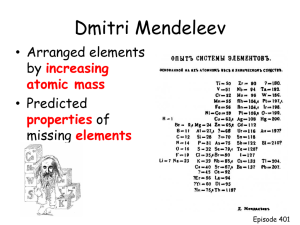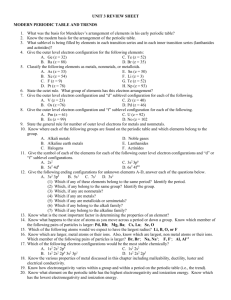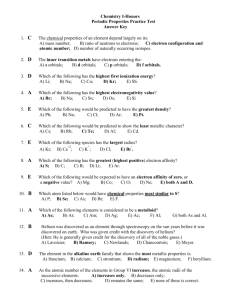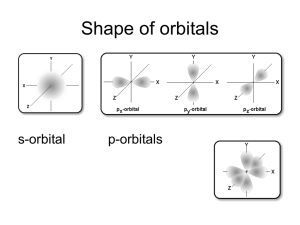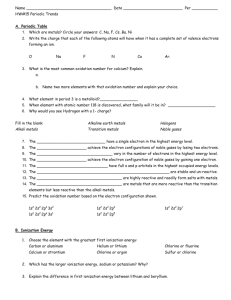Chapter 5 Chapter Review Question Answers
advertisement
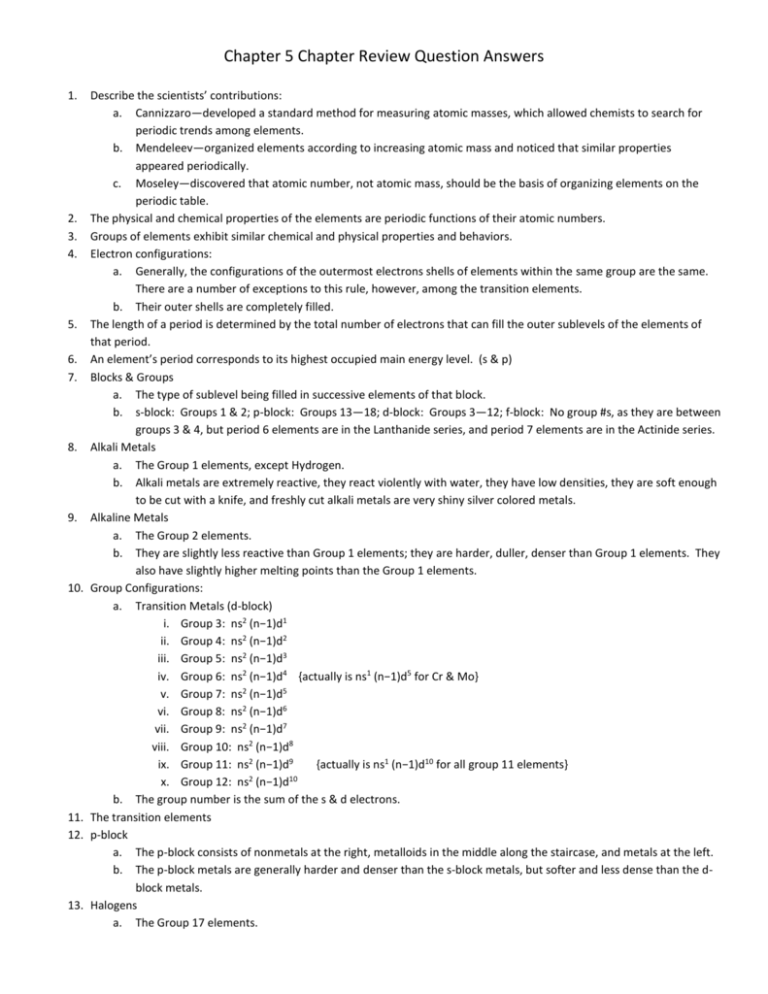
Chapter 5 Chapter Review Question Answers
1.
2.
3.
4.
5.
6.
7.
8.
9.
10.
11.
12.
13.
Describe the scientists’ contributions:
a. Cannizzaro—developed a standard method for measuring atomic masses, which allowed chemists to search for
periodic trends among elements.
b. Mendeleev—organized elements according to increasing atomic mass and noticed that similar properties
appeared periodically.
c. Moseley—discovered that atomic number, not atomic mass, should be the basis of organizing elements on the
periodic table.
The physical and chemical properties of the elements are periodic functions of their atomic numbers.
Groups of elements exhibit similar chemical and physical properties and behaviors.
Electron configurations:
a. Generally, the configurations of the outermost electrons shells of elements within the same group are the same.
There are a number of exceptions to this rule, however, among the transition elements.
b. Their outer shells are completely filled.
The length of a period is determined by the total number of electrons that can fill the outer sublevels of the elements of
that period.
An element’s period corresponds to its highest occupied main energy level. (s & p)
Blocks & Groups
a. The type of sublevel being filled in successive elements of that block.
b. s-block: Groups 1 & 2; p-block: Groups 13—18; d-block: Groups 3—12; f-block: No group #s, as they are between
groups 3 & 4, but period 6 elements are in the Lanthanide series, and period 7 elements are in the Actinide series.
Alkali Metals
a. The Group 1 elements, except Hydrogen.
b. Alkali metals are extremely reactive, they react violently with water, they have low densities, they are soft enough
to be cut with a knife, and freshly cut alkali metals are very shiny silver colored metals.
Alkaline Metals
a. The Group 2 elements.
b. They are slightly less reactive than Group 1 elements; they are harder, duller, denser than Group 1 elements. They
also have slightly higher melting points than the Group 1 elements.
Group Configurations:
a. Transition Metals (d-block)
i. Group 3: ns2 (n−1)d1
ii. Group 4: ns2 (n−1)d2
iii. Group 5: ns2 (n−1)d3
iv. Group 6: ns2 (n−1)d4 {actually is ns1 (n−1)d5 for Cr & Mo}
v. Group 7: ns2 (n−1)d5
vi. Group 8: ns2 (n−1)d6
vii. Group 9: ns2 (n−1)d7
viii. Group 10: ns2 (n−1)d8
ix. Group 11: ns2 (n−1)d9
{actually is ns1 (n−1)d10 for all group 11 elements}
2
10
x. Group 12: ns (n−1)d
b. The group number is the sum of the s & d electrons.
The transition elements
p-block
a. The p-block consists of nonmetals at the right, metalloids in the middle along the staircase, and metals at the left.
b. The p-block metals are generally harder and denser than the s-block metals, but softer and less dense than the dblock metals.
Halogens
a. The Group 17 elements.
b.
14.
15.
16.
17.
18.
19.
20.
21.
22.
23.
The halogens are the most reactive nonmetal elements; they react violently with most metals to form salts. They
are also among the most electronegative elements.
Metalloids
a. B, Si, Ge, As, Sb, Te, are the metalloids. Al & Po occupy metalloid positions on the staircase, but their properties
are much more metallic, and therefore are considered metals.
b. The matalloids are mostly brittle solids with electrical conductivities intermediate between those of metals
(excellent conductors of heat and electricity) and nonmetals (poor conductors of heat and electricity).
The f-block elements are the lanthanides and actinides.
Main Group elements
a. The elements of the s- & p-blocks are the main group elements, along with hydrogen & helium.
b. Main group element period trends:
i. Atomic size: Decreases
ii. Ionization energy: Increases
iii. Electron affinity: Increases
iv. Ionic size: Decreases
v. Electronegativitiy: Increases
Noble gas abbreviated electron configurations
a. Li [He] 2s1
b. O [He] 2s2 2p4
c. Cu [Ar] 4s2 3d9 {actually 4s1 3d10}
d. Br [Ar] 4s2 3d10 4p5
e. Sn [Kr] 5s2 4d10 5p2
ID period, block, & group
a. [Ne] 3s2 3p4
Period: 3
Block: p
Group: 16
b. [Kr] 5s2 4d10 5p2
Period: 5
Block: p
Group: 14
2
14
10
5
c. [Xe] 6s 4f 5d 6p
Period: 6
Block: p
Group: 17
ID element, period, block & group
a. [He] 2s2
Period: 2
Block: s
Group: 2
Element: Beryllium, Be
b. [Ne] 3s1
Period: 3
Block: s
Group: 1
Element: Sodium, Na
2
c. [Ar] 5s
Period: 5
Block: s
Group: 2
Element: Strontium, Sr
d. [Kr] 4s2
Period: 4
Block: s
Group: 2
Element: Calcium, Ca
1
5
e. [Kr] 4s 3d
Period: 4
Block: d
Group: 6
Element: Chromium, Cr
Write the valence electron configuration
a. Group 7, 4th Period:
[Ar] 4s2 3d6
th
b. Group 3, 5 Period:
[Kr] 5s2 4d1
c. Group 12, 6th Period:
[Xe] 6s2 4f14 5d10
ID the Block, Period, Group Name (if applicable), element name, Element type, & Relative Reactivity:
a. [Ne] 3s2 3p1
p-block, Period 3, Aluminum, Metal, High Reactivity
b. [Ar] 4s2 3d10 4p6
p-block, Period 4, Krypton, (Noble Gas), Nonmetal, Low Reactivity
1
10
c. [Kr] 5s 4d
d-block, Period 5, Silver, Metal, Low reactivity
d. [Xe] 6s2 4f1 5d1
f-block, Period 6, Cerium, (Actinide Series), Metal, High Reactivity
Atomic Radius & Period
a. Atomic Radius is the half the distance between two nuclei of two chemically bonded, identical atoms.
b. Atomic radius decreases across the period of the main group elements.
c. As electrons are added to s and p sublevels in the same main energy level, the increasing positive charge of the
nucleus pulls the electrons closer to the nucleus as the electrons are not placed in levels further away from the
nucleus. As a result, the size of the atom decreases.
Atomic Radius & Group
a. Increases.
b. Down a group, the outer electrons of each element occupy the same sublevels, but in higher main energy levels
that are farther from the nucleus each successive period.
24. Definitions:
a. Ion—a charged atom or a charged group of bonded atoms.
b. Ionization—any process that forms an ion.
c. First Ionization Energy—the energy required to remove on electron from a neutral atom of an element.
d. Second Ionization Energy—the energy required to remove an electron from a +1 ion of an element.
25. Ionization Energy Trends
a. Increases across a period and decrease down a group.
b. Across a period, the increasing nuclear charge attracts electrons in the same energy level more strongly and makes
them more difficult to remove. Down a group, the electrons to be removed from each successive element are
farther from the nucleus in increasingly higher energy levels and are thus more easily removed.
26. Electron Affinity Trends
a. The energy taken in or given off when an electron is added to a neutral atom.
b. Electron Affinity values are either positive or negative. Negative values indicate that energy is given off, and
positive values indicate that energy is absorbed.
27. Ions
a. A cation is an ion with a positive charge. An anion is an ion with a negative charge.
b. Cations are smaller than the atoms from which they are formed. Anions are larger than the atoms from which
they are formed.
28. Valence Electrons
a. Valence electrons are the electrons of an atom that are available to be lost, gained, or shared in the formation of
chemical compounds during chemical reactions.
b. Valence electrons are the electrons located in the outermost energy levels.
29. Lose or Gain Electrons
a. Lost 1
b. Lost 2
c. Lost 3
d. Gained 2
e. Gained 1
f. Neither lost nor gained
30. Electronegativity
a. Electronegativity is the ability of an atom to attract electrons from other atoms.
b. Fluorine is the most electronegative element and has been arbitrarily given the electronegativity value of 4.0. the
values for all other elements are assigned electronegative values relative to Fluorine’s 4.0
31. The most electronegative group is Group 17 (The Halogens). The least electronegative group is Group 1 (The Alkali Metals).
32. Gold would have the smallest atomic radius, as it the furthest to the right of the given elements, all of which are located in
the same period, and atomic radii decrease across a period.
33. Multiple Ionization Energies
a. The first ionization energy is the energy required to remove on electron from a neutral atom. Second ionization
energy is the energy required to remove an electron from a +1 ion. Third ionization energy is the energy required
to remove an electron from a +2 ion.
b. In all atoms, the successive ionization energy is larger than the preceding one. (Pattern is still the same!!)
34. The order for decreasing electron affinities for the given elements is: F, O, C, Li, Na, Rb.
35. Ionization Energy Ordering
a. Order of decreasing first ionization energies: Ne, F, O, C, Li, K.
b. The element with the highest 2nd ionization energy is Li. Both Li and K will have stable noble gas configurations
after losing their s1 electron from the 1st ionization energy. Therefore they would have the highest 2 nd ionization
energy to remove an electron from the stable noble gas configuration. Li would have a higher value because its +1
ion is smaller than the K +1 ion, so it would be harder to remove the next electron in Li!
36. Ion formation likelihood
a. K+2 because after K+, you would be removing from a stable electron configuration (noble gas electron
configuration)
b. None of these!! They are all likely to form, as they all produce a stable noble gas electron configuration!
37. The element that is the most electronegative from the elements provided is Oxygen. It is in group 16.
38. Ca+2 would have a smaller radius than K+ because it has a stronger net positive charge and would contract the electron
cloud closer to its nucleus. The periodic trend confirms this, as calcium is further to the right of potassium and ionic radius
decreases across a period.
39. ID the Period, Block, and Group
a. [Rn] 7s1
Period: 7
Block: s
Group: 1
b. [Ar] 4s2 3d2
Period: 4
Block: d
Group: 4
1
10
c. [Kr] 5s 4d
Period: 5
Block: d
Group: 11
d. [Xe] 6s1 4f14 5d9
Period: 6
Block: d
Group: 10
40. Noble Gases
a. The Group 18 Elements
b. They are very nonreactive elements
41. The ion that does not have a noble gas configuration is Ca+.
42. Groups, Periods, Main Group & Blocks
a. There are 18 groups on the periodic table of elements.
b. There are 7 periods on the periodic table of elements.
c. The s-block & p-block make up the main group elements.
43. Noble-Gas Notation & Period and Group
a. Mg [Ne] 3s2
Period: 3
Group: 2
b. P [Ne] 3s2 3p3
Period: 3
Group: 15
2
1
c. Sc [Ar] 4s 3d
Period: 4
Group: 3
d. Y [Kr] 5s2 4d1
Period: 5
Group: 3
44. Periodic Table & Chemical Properties
a. Fluorine, F: Located in Period 2, Group 17, it is a very reactive nonmetal, and member of the halogen family.
b. Xenon, Xe: Located in Period 5, Group 18, it is a very nonreactive nonmetal, member of the noble gases.
c. Sodium, Na: Located in Period 3, Group 1, it is a very reactive metal, and member of the alkali metals.
d. Gold, Au: Located in Period 6, Group 11, it is a very nonreactive metal, and found in the least reactive metal group
in the transition metal region (d-block).
45. Ions & Noble Gas Electron Configurations of Them
a. Li
Li+
He
1s2
b. Rb
Rb+
Kr
1s2 2s2 2p6 3s2 3p6 4s2 3d10 4p6
−2
c. O
O
Ne
1s2 2s2 2p6
d. F
F−
Ne
1s2 2s2 2p6
+2
e. Mg
Mg
Ne
1s2 2s2 2p6
f. Al
Al+3
Ne
1s2 2s2 2p6
−3
g. P
P
Ar
1s2 2s2 2p6 3s2 3p6
h. S
S−2
Ar
1s2 2s2 2p6 3s2 3p6
−
i. Br
Br
Kr
1s2 2s2 2p6 3s2 3p6 4s2 3d10 4p6
j. Ba
Ba+2
Xe
1s2 2s2 2p6 3s2 3p6 4s2 3d10 4p6 5s2 4d10 5p6
46. The s-block metals and d-block metals differ in many ways. For example, the s-block elements are softer, less dense, more
reactive, and have lower melting points (except for mercury in the melting point department).
47. The halogens only form −1 ions because they need to gain 1 electron to have a stable noble gas electron configuration.
48. ID the trends with the diagrams:
a. Electronegativity, Ionization Energy, Electron Affinity
b. Atomic Radius
c. This diagram does not represent any of the given properties.
49. Though Chlorine, Argon, and Potassium vary by 1 electron progressively, their properties are very different. Chlorine,
Potassium are very reactive, Argon is a very nonreactive noble gas. Chlorine will gain 1 electron to have Argon’s noble gas
configuration, and Potassium will lose one electron to have Argon’s noble gas configuration.
